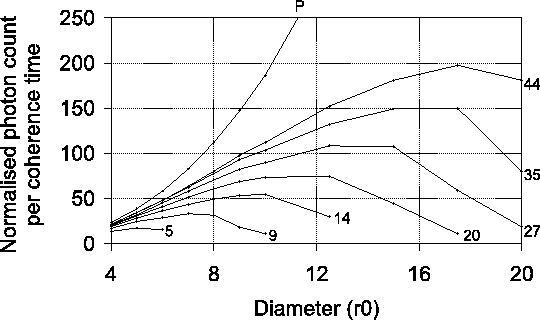: Impact on astrometry : Detailed contributions : Simulations of PRIMA operation 目次
Simulations of PRIMA performance with the UTs have not been
undertaken, however some estimates of the probable performance can be
made using general properties of optical
interferometers. Figure 25 shows the light
collected through a spatial filter per coherence time of the
interference fringes for a typical interferometer with different
levels of AO correction (but all under the same seeing conditions). In
this case the AO correction involved ideal compensation of a finite
number of Zernike modes (with the modes matched to the aperture
diameter used). The decrease in signal for large apertures and
low-order AO correction is due to the reduced coherence time for the
fringes when the variance in the wavefront phase across the aperture
increases beyond ![]() radian. It is not clear which (if any) of these
curves would correspond to the MACAO system. It is interesting to note
that the S/N ratio is optimised when the Strehl ratio is
radian. It is not clear which (if any) of these
curves would correspond to the MACAO system. It is interesting to note
that the S/N ratio is optimised when the Strehl ratio is ![]() for all the AO correction models shown here. More realistic
simulations of the VLTI would probably be required in order to
optimise the operation of PRIMA using the UTs.
for all the AO correction models shown here. More realistic
simulations of the VLTI would probably be required in order to
optimise the operation of PRIMA using the UTs.
 |
Robert Tubbs 平成16年11月18日